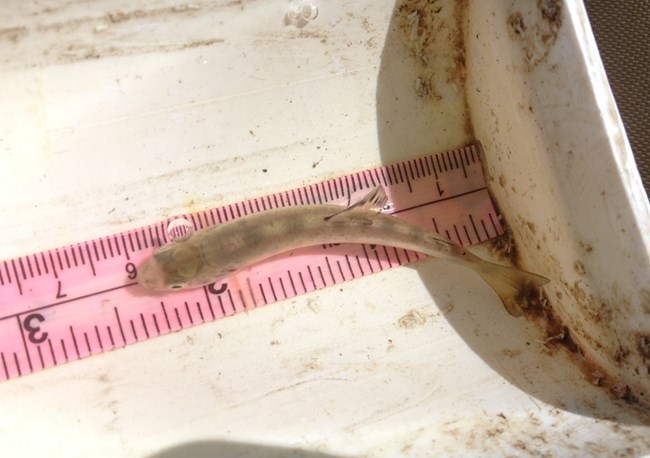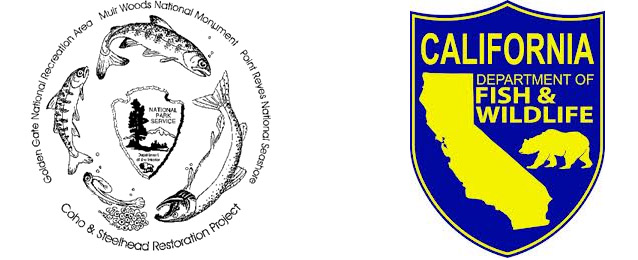Last updated: July 8, 2025
Article
Spring 2017 Downstream Migrant Trapping Summary
- Coho and Steelhead Monitoring Program
Happening Now!
Although our smolt trapping season has come to a close, our summer monitoring is underway. Summer monitoring will provide juvenile coho and steelhead population size and distribution data for Olema, Pine Gulch, and Redwood Creeks. To obtain this information we use a combination of snorkeling and electrofishing surveys that will continue through September. Snorkeling and electrofishing provide excellent opportunities to monitor and observe a wide variety of aquatic species including coho salmon, steelhead trout, stickleback, sculpin, and salamanders.
Thank you to all of the volunteers who participated in the 2017 downstream migrant trapping surveys on Olema and Redwood Creeks! Through your dedication and flexibility, we were able to successfully run traps at three locations throughout the spring.
Trapping Season Overview
The 2017 coho and steelhead smolt trapping season began in mid-March. We constructed two traps on Redwood Creek and one trap on Olema Creek. One of the Redwood Creek traps was a backwater trap constructed in addition to our normal mainstem trap. It was used to assess how salmonids use the creek backwater during the late winter/early spring months. The mainstem trap was installed just upstream of the backwater trap to estimate the total number of coho smolts leaving Redwood Creek. Together, the traps assist in assessing the success of recent restoration work, as well as help monitor Redwood Creek’s annual coho smolt outmigration.
The Olema Creek trap was placed approximately 1.5 km upstream of the confluence with Lagunitas Creek and downstream of the town of Olema. Like the mainstem Redwood Creek trap, it was used to assess coho smolt outmigration.
Results
Total Smolt Captures & Production Estimates
The mainstem Redwood Creek trap was in operation for 63 days and captured a total of 612 coho smolts. The backwater Redwood Creek trap was in operation for 44 days and captured one coho smolt on April 3rd. The Olema Creek trap was in operation for 60 days and captured a total of 1,145 coho smolts.
Figures 1 & 2 show coho smolt production estimates, or the estimated total number of smolts emigrating to saltwater, for each monitored watershed. The estimates are based on the total number of fish captured, as well as on our understanding of other factors like typical fish survival and trap effectiveness. The preliminary 2017 coho smolt production estimate for Redwood Creek is 897 smolts (SE 160). The preliminary 2017 coho smolt production estimate for Olema Creek is 5,698 smolts (SE 587).


Migration Timing
The mainstem Redwood Creek trap captured its first smolt on March 16. Outmigration peaked on Redwood Creek during the ninth week of trapping (May 9-May 15), when a total of 207 coho smolts were captured. The timing of peak outmigration was a week later than historic peak captures at this location.
The first coho smolt capture on Olema Creek occurred on April 2. The Olema Creek outmigration peaked during the seventh week of trapping (April 25-May 1) when a total of 442 coho smolts were caught.

Madison Halloran / NPS
Fish Size
Fork length, or the length of a fish from its snout to the fork in its caudal (tail) fin, is one measure of fish size recorded for all captured smolts. On the Redwood Creek mainstem, the average 2017 coho smolt length was 107 mm, smaller than the historic average. Redwood Creek steelhead smolts were also smaller than average in 2017, with an average fork length of 142 mm.
The average fork length of coho smolts captured in Olema Creek in 2017 was 121 mm, the highest average length on record for the Creek since monitoring began. The average fork length of Olema Creek steelhead smolts was 157 mm, similar to historic average.
PIT Tagging and Fish Growth
For the ninth consecutive trapping season, passive integrated transponders (PIT tags) were used to tag a portion of the captured coho smolts. These tags individually identify every tagged fish and provide us with a variety of useful data. For example, during the smolt trapping season, they are used to gauge the efficiency of the mainstem traps, and to calculate production estimates for each watershed.
These same PIT tagged fish can turn up in the course of future monitoring efforts as well. For instance, coho smolts tagged during the 2017 trapping season can be detected again when they return as adults during the winter of 2018-2019. Such recapture information can then be used to increase the accuracy of adult return estimates and improve our understanding of the factors that affect smolt survival in the ocean.
A total of 246 coho smolts were PIT tagged this year in Redwood Creek. We also captured 22 coho smolts that had been tagged during the summer of 2016. With measurements on record from their first capture, PIT tagged fish provide an opportunity to learn about fish growth. These recaptured fish showed an average increase of 31 mm in fork length and 7.1 g in weight (Table 1).
On Olema Creek, we tagged 426 coho smolts. We also recaptured nine coho smolts that were tagged as juveniles in the summer of 2016. On average, these recaptured fish showed an increase of 51 mm in length and 12.4 g in weight (see Table 1.).
|
Creek |
Year |
Number of PIT tagged coho recaptured |
Average weight increase(summer to spring) |
Average fork length increase (summer to spring) |
|
|---|---|---|---|---|---|
|
Redwood |
2010 |
4 |
10.5 g |
40 mm |
|
|
Redwood |
2011 |
52 |
9.4 g |
34 mm |
|
|
Redwood |
2012 |
2 |
14.4 g |
48 mm |
|
|
Redwood |
2013 |
7 |
10.9 g |
39 mm |
|
|
Redwood |
2014 |
20 |
11.8 g |
44 mm |
|
|
Redwood |
2015 |
1 |
0 g |
7 mm |
|
|
Redwood |
2016 |
13 |
16.7 g |
53 mm |
|
|
Redwood |
2017 |
22 |
7.1 |
32mm |
|
|
|
|
|
|
|
|
|
Olema |
2011 |
3 |
8.1 g |
35 mm |
|
|
Olema |
2012 |
3 |
11.2 g |
38 mm |
|
|
Olema |
2013 |
0 |
NA |
NA |
|
|
Olema |
2014 |
10 |
10.2 g |
43 mm |
|
|
Olema |
2015 |
5 |
8.8 g |
41 mm |
|
|
Olema |
2016 |
15 |
11.0 g |
40 mm |
|
|
Olema |
2017 |
9 |
12.4 g |
51 mm |
|
Other Species
Other fish species captured this season included California roach, stickleback, sculpin, bluegill, and a golden shiner.
For More Information
To learn more abour this program, contact:
Michael Reichmuth
Fishery Biologist, San Francisco Bay Area Inventory & Monitoring Program
415-464-5191
The National Park Service shall not be held liable for improper or incorrect use of the data described and/or contained herein. These data and related graphics (if available) are not legal documents and are not intended to be used as such. The information contained in these data is dynamic and may change over time. The National Park Service gives no warranty, expressed or implied, as to the accuracy, reliability, or completeness of these data.

